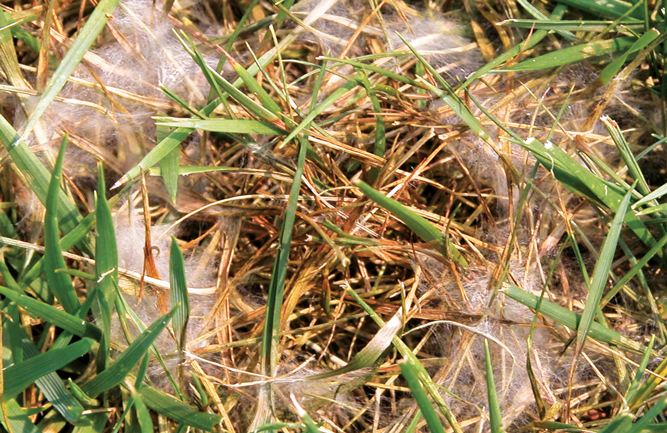How to prevent Pythium blight in cool-season turf

Also known as cottony blight, Pythium blight thrives in warm and wet conditions on cool-season grasses. (Photo: Syngenta)
Considered a water mold, Pythium blight generally occurs in areas of the course with poor drainage or prolonged wetness for extended periods. Jim Kerns, Ph.D., associate professor in the Department of Entomology and Plant Pathology at North Carolina State University, says the pathogen is most severe for cool-season grasses whenever conditions are warm and wet. The most susceptible species are perennial ryegrass, annual bluegrass, fescues, Kentucky bluegrass and creeping bentgrass.
Kerns says Pythium blight can be destructive if turf strands are wet for prolonged periods. It’s also rare for the disease to develop on sand-based putting greens or on sand-based soil types. Kerns says Midwestern superintendents may see Pythium blight on fairways with silty soils.
“Ultradwarf bermudagrass putting greens are prone to Pythium blight in southern climates,” he says. “Even though the disease is most severe under cloudy, wet conditions, it has been seen on these surfaces at various times of the year. Typically, we see most of it on bermudagrass putting greens in the fall and early winter.”
Ounce of prevention
If superintendents grow perennial ryegrass in fairways or roughs, or if they overseed the course’s fairways and roughs, preventative applications are extremely important. Kerns says preventative applications for other cool-season turfgrasses will depend on the course’s soil type. For example, courses on native soil that don’t topdress greens need a preventative program.
“For many putting greens, though, a staple in a fungicide program is a phosphonate fungicide like Signature Xtra Stressgard (O-ethyl phosphonate) or Appear II (potassium phosphite),” he says. “Superintendents should mix it with a contact fungicide, such as chlorothalonil, mancozeb or fluazinam and then apply it frequently during periods that are conducive for Pythium blight.”
Kerns says superintendents with ultradwarf putting greens should apply phosphonate and contact fungicides in late summer and fall.
Corteva Agriscience

Justin Stewart (Photo: Corteva Agriscience)
Justin Stewart
Turf and ornamental Eastern district leader
Pythium blight needs hot, humid weather, particularly when nightly lows are above 68 degrees F and relative humidity is higher than 90 percent for extended periods of time. Scouting should start as soon as superintendents have three nights in a row under these conditions. It’s also important to remember that it’s a high-nitrogen disease, meaning that areas of the course pounded with nitrogen — like greens, tees and fairways — will often be more susceptible to it. The disease can quickly destroy a golf course, too, as I’ve witnessed entire fairways decimated within 24 hours under high-pressure conditions. To protect high-value areas and prevent rapid destruction, like greens and tees, superintendents should always treat preventively. Depending on superintendents’ locations, they’ll want to apply their preventative products early and often, starting before the summer heat.

Bret Corbett (Photo: Prime Source)
Prime Source
Bret Corbett
Technical services manager
Pythium blight, also known as “cottony blight,” first appears as small, sunken, mostly circular patches. The name cottony blight refers to the white, fluffy mycelium that forms on the leaves of the infected plants. This disease develops once nighttime temperatures exceed 60 degrees on leaves that are continually wet for 12 to 14 hours on consecutive nights. By reducing prolonged leaf wetness — via early morning watering prior to sunrise — along with avoiding excess nitrogen, superintendents will decrease disease pressure. Also, avoid mowing or irrigating when the mycelium is present. For chemical control, there are a handful of options, such as active ingredients cyazofamid or mefenoxam, along with combination QoI fungicides. Superintendents can also utilize chemical alternatives like the biological bacterium Burkholderia, as well as phosphite fertilizers.

Photo: Brian Aynardi, Ph.D.
PBI-Gordon
Brian Aynardi, Ph.D.
Northeast research scientist
Pythium blight can occur on all turfgrass, but perennial ryegrass, Poa annua, creeping bentgrass and bermudagrass greens are the most susceptible and concerning. On cool-season species, specific environmental conditions are necessary for development: less than 90 percent relative humidity for 14 consecutive hours, daytime temperatures above 85 degrees F and nighttime lows above 65 degrees F. On warm-season turfgrass, overcast and humid conditions, accompanied by rainfall and cooler temperatures (like below 80 degrees F), are optimal. Regardless of the host type, extended periods of free leaf moisture and high relative humidity are key for disease development. Therefore, preventative treatment for Pythium blight is likely the most critical preventive fungicide application a superintendent can make.

Lane Tredway (Photo: Syngenta)
Syngenta
Lane Tredway, Ph.D.
Technical services manager
Pythium blight can attack any turfgrass, including both warm- and cool-season species. On cool-season grasses, it will occur in hot and humid conditions. Nighttime temperatures of 68 degrees F or higher, along with long periods of leaf wetness, are the most conducive. In warm-season turfgrasses, Pythium blight attacks under cool, cloudy and wet conditions from fall to early spring. Ultradwarf bermudagrass greens are the most susceptible to Pythium blight, and the symptoms are often mistaken for leaf spot, which occurs under very similar conditions. Because Pythium develops so quickly, prevention is the best management approach.
Products containing azoxystrobin are all useful as part of a preventative program. Meanwhile, a plant activator, known as acibenzolar-s-methyl, provides additional suppression by triggering turfgrass’s natural defenses against Pythium.

Ken Hutto (Photo: FMC)
FMC
Ken Hutto, Ph.D.
Product development manager for herbicides and fungicides
Pythium blight can be a destructive disease, which develops quickly on cool-season turfgrass, particularly under the right conditions. The risk of disease development is highest under high humidity, several hours of continuous leaf wetness, daytime temperatures near 90 degrees F and nighttime temperatures above 68 F degrees. It can affect several turfgrass types on golf courses, too, from rough to putting greens, including ultradwarf bermudagrass greens. Ultradwarf bermudagrass is most susceptible to Pythium blight under cloudy conditions whenever temperatures are above 50 degrees F. Superintendents may notice blight symptoms following drain patterns in susceptible areas, as water can transport spores. It’s important to initiate a preventative 14-day interval program once the forecast predicts environmental conditions that favor Pythium blight development.

Aaron Hathaway (Photo: Nufarm)
Nufarm Americas
Aaron Hathaway
Technical services manager
Since Pythium blight can devastate infected turf stands quickly, it’s important to forecast when pressure may be high and then take appropriate preventative actions. As always, the disease triangle (host, environment and pathogen) is a useful tool for understanding the increased potential for Pythium blight damage. Hosts especially prone to this foliar disease are perennial ryegrass, rough bluegrass, creeping bentgrass and annual bluegrass, and it’s most active with elevated temperatures and moisture levels. The pathogen overwinters in soil and plant debris. Focus your prevention and/or scouting on previous problem areas. Also, look for water-soaked leaves and stems within the canopy and small, circular collapsed patches if you pursue a curative approach, and apply fungicides quickly whenever you positively identify Pythium blight.
Quali-Pro

Justin Ruiz (Photo courtesy of Control Solutions Inc.)
Justin Ruiz, CGCS, MG
West area manager
Pythium blight usually requires high heat and high humidity, along with extended periods of leaf wetness. It needs free water to travel from plant to plant, which is often why it will run down hills, in tire tracks, along mower roller paths and in clean-up passes. Superintendents can usually identify Pythium blight, due to its cottony mycelium in the mornings and the purplish, grease-soaked spots they’ll notice on affected turf. The rule of thumb is when they add the air temperature with the percent humidity and have a number above 150, they’ll have ideal conditions. To prevent Pythium, it’s important to rotate applications. Since Pythium can produce many spores, resistance can occur fairly quickly if superintendents overuse the same active ingredients.











